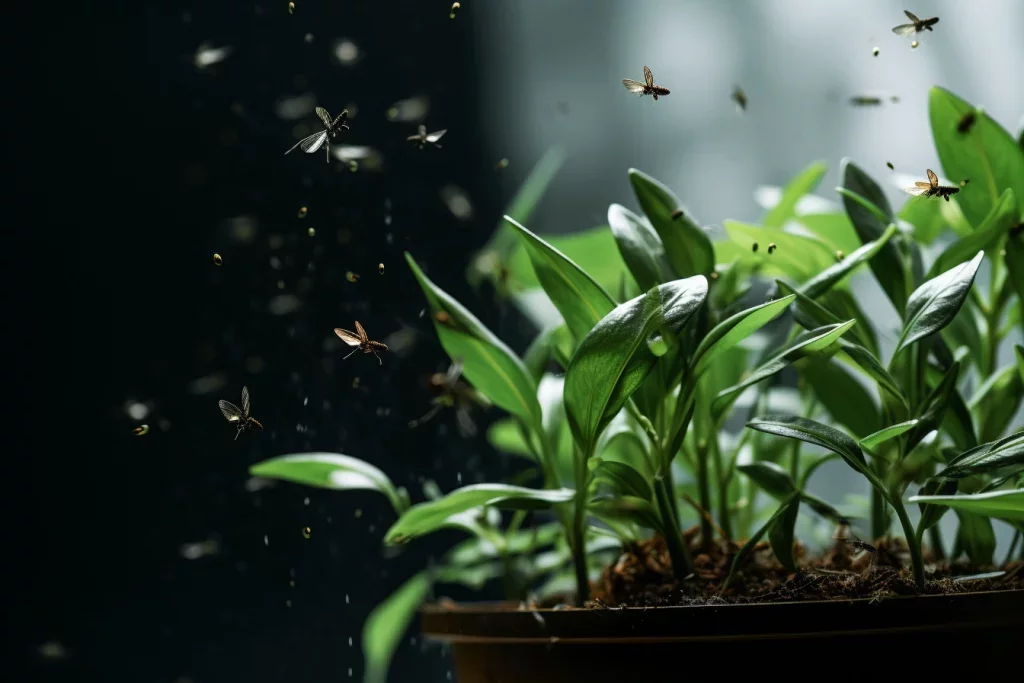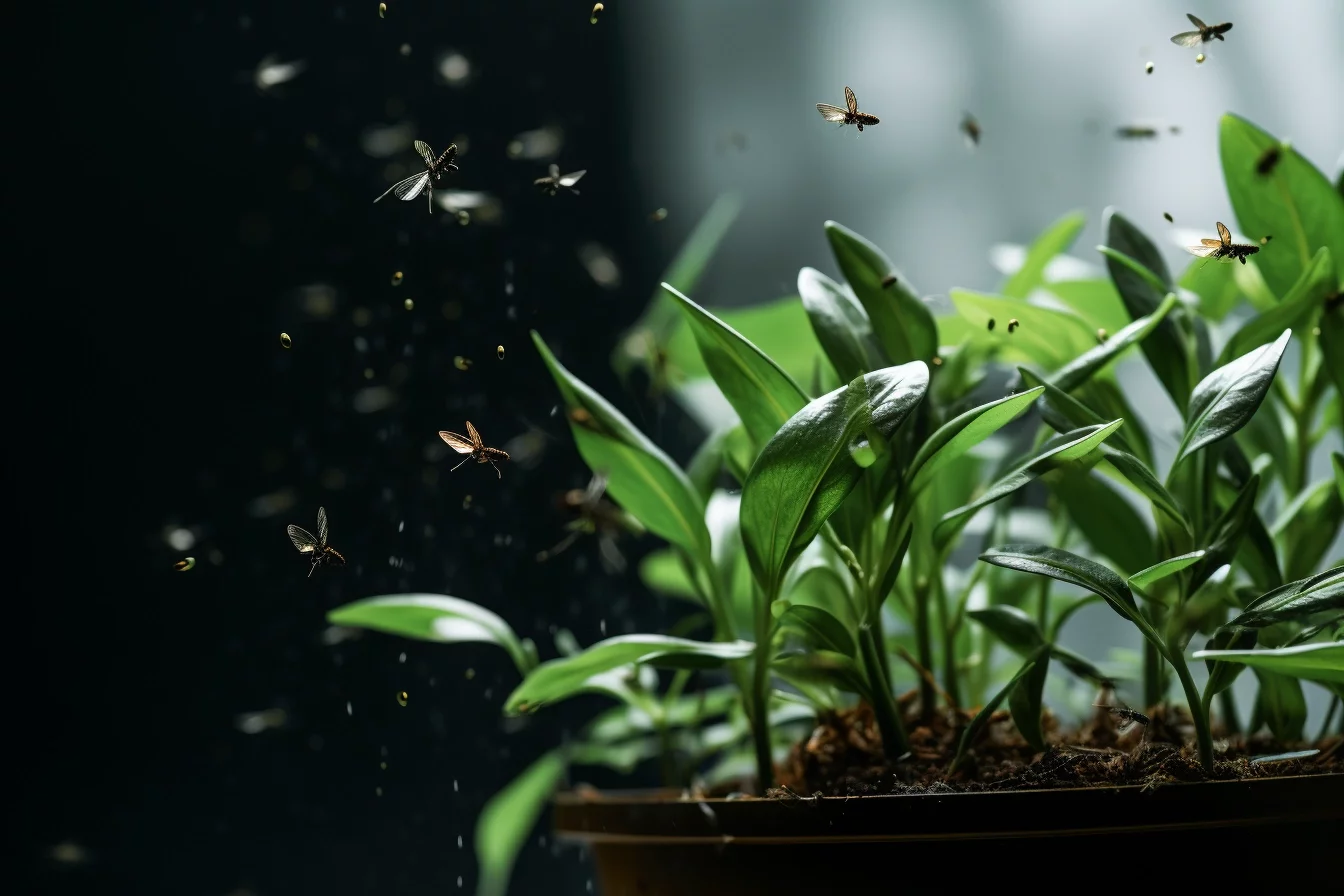As an avid gardener and plant enthusiast, I’ve had my fair share of battles with various pests. However, one of the most persistent and frustrating has been my war against fungus gnats. These tiny flies are more than just a nuisance; they can wreak havoc on your beloved plants. I want to share with you my journey, complete with the highs and lows, and ultimately, the effective strategy I developed to eliminate these pests.
Nicknames: genus Bradysia, fungus midge, manure fly, mushroom fly, and drain fly

🦟 The Start of the Infestation: A Sticky Situation
It all began with noticing a few flies around my indoor plants. I didn’t think much of it until the number rapidly increased. To address this, I used sticky yellow traps. While these traps were somewhat effective in capturing adult gnats, I soon realized that they were just a band-aid solution.
🌱 The Real Culprit: Larvae in the Soil
What I didn’t initially realize was that the real problem was lurking beneath the soil. Fungus gnat larvae feed on plant roots, and my precious plants were under siege. The yellow traps weren’t enough; I needed a solution that addressed the root of the problem—literally.
❌ Trial and Error: Neem Oil and Gravel Mulching
In my quest to eradicate these pests, I turned to neem oil, a popular organic pesticide. Diligently, for over five weeks, I applied neem oil to my plants. Despite my efforts, the gnats persisted. Frustrated, I tried another method: mulching with gravel. This was meant to prevent the gnats from reaching the soil to lay eggs. However, this made it difficult to monitor the condition of my orchid’s media, and I had to abandon this approach.
🌧️ Watering Woes: The Challenge of a Humid Environment
I read about letting the soil dry out to kill the larvae, but this was not feasible in my humid living environment. Additionally, I must confess to a habit of overwatering my plants, which only exacerbated the issue.
🔍 A Turning Point: Understanding the Fungus Gnat Life Cycle
I realized I needed a comprehensive plan that tackled all life stages of the fungus gnat: eggs, larvae, pupae, and adults. This was the key insight that changed my approach.
🌿 The Three-Pronged Attack: My Winning Strategy
After much research and trial, I implemented a three-pronged attack:
- Contact Killer Spray: I used a safe, plant-friendly insecticide spray to kill adult gnats on contact. This helped reduce the number of gnats laying eggs.
- Sticky Traps: I continued using sticky traps to catch adult gnats, but now as a complementary measure rather than my main strategy.
- Soil Drench: The game-changer was using a soil drench that targeted the larvae and eggs. This involved using a specific solution that I could water my plants with, which would kill the gnats in the soil without harming my plants.
🔁 Consistency is Key: Repeated Application
Eradicating fungus gnats wasn’t an overnight success. It required consistent application of my three-pronged strategy, especially during watering. Over time, this method proved effective in not just reducing, but completely eliminating the gnats.
🚪 Prevention: Keeping the Gnats at Bay
To prevent future infestations, I began regularly treating my plants, especially near potential entry points like doors and windows. I also became more mindful of not overwatering my plants and ensuring proper drainage to create a less hospitable environment for gnats.
🌟 Final Thoughts
Winning the battle against fungus gnats was a journey of patience, persistence, and learning. It was a reminder that often, the most effective solutions require understanding the problem deeply and tackling it from multiple angles. For fellow plant lovers facing similar struggles, I hope my experience offers not just guidance, but also the reassurance that with the right approach, you can reclaim your home and gardens from these pesky intruders.
Remember, each plant and home environment is unique, so what worked for me might need some adjustment for your situation. Stay vigilant, be consistent, and most importantly, don’t lose hope. Your green oasis can be saved from the clutches of fungus gnats!🌱🌿💚

FAQ: Effective Ways to Get Rid of Gnats (Bradysia spp.) 🐜
1. What are Gnats?
Gnats, including fungus midges (Bradysia spp.), manure flies, mushroom flies, and drain flies, are tiny flying insects often found indoors and outdoors. They thrive in moist environments and can be a nuisance in homes and gardens.
2. What Attracts Gnats in My Home?
Gnats are attracted to organic matter such as overripe fruit, rotting food, and damp soil in potted plants. Indoor areas like the kitchen sink, sink drain, and garbage disposals are common breeding grounds due to food sources and moisture.
3. How Can I Identify Different Types of Gnats?
Fungus gnats (Bradysia spp.), often found in houseplants, resemble fruit flies but are drawn to moist soil rather than fruits and vegetables. Drain flies, or sewer gnats, are typically found around sink drains and garbage disposals.
4. Are Gnats Harmful? Do They Bite?
Most gnats, like Bradysia species, don’t bite but can be a nuisance. However, some types, like certain outdoor gnats, can bite and should be managed differently.
5. How Can I Prevent Gnats Indoors?
To prevent gnats:
- Keep your home clean, especially areas where food is prepared and consumed.
- Avoid overwatering houseplants and let the soil of potted plants dry between waterings.
- Seal fruits and vegetables or store them in the refrigerator.
- Regularly clean sink drains and garbage disposals to eliminate potential gnat breeding sites.
6. What Are Some Effective Home Remedies to Get Rid of Gnats?
Some popular home remedies include:
- Vinegar Trap: Mix apple cider vinegar with a few drops of dish soap in a bowl, cover with plastic wrap, and poke small holes. Gnats are drawn to the vinegar and get trapped.
- Dish Soap Solution: Add a few tablespoons of apple cider vinegar and a few drops of dish soap to a bowl of water. This solution can catch and kill gnats.
- Light a Candle: Place a candle in a bowl of water and light it. The gnats will flock to the flame and fall into the water.
7. Can I Use Chemical Pest Control to Get Rid of Gnats?
Yes, chemical pest control can be effective. Products that target gnats can kill them on contact. However, it’s essential to use these products safely and according to the manufacturer’s instructions.
8. What About Gnats in Houseplants?
For gnats in houseplants:
- Allow the soil to dry out between waterings to discourage gnats.
- Apply a soil drench designed to target fungus gnats.
- Introduce natural predators like nematodes that feed on gnat larvae.
9. Are There Any Long-term Solutions to Keep Gnats Away?
Long-term solutions include:
- Ensuring good drainage in potted plants and not overwatering.
- Keeping your home clean and free of decomposing organic matter.
- Regularly inspecting and cleaning drains and garbage disposals.
- Using screens on windows and doors to prevent gnats from entering.
10. How Can I Deal with Gnats Outside My Home?
For outdoor gnat problems:
- Keep outdoor plants well-maintained and avoid overwatering.
- Remove any standing water in your yard.
- Use outdoor bug zappers or traps designed for gnats.
- Consider using natural repellents or essential oils in areas where gnats congregate.
11. Can Overwatered Plants Attract Gnats?
Yes, overwatered plants create the perfect breeding ground for fungus gnats. Ensure proper drainage and allow the soil surface to dry between waterings.
12. Should I Be Concerned About Gnats in New Plants?
Always inspect new plants for signs of gnats before bringing them indoors. Quarantining new plants for a few days can help prevent the spread of gnats to other houseplants.
Remember, the key to controlling gnats, whether they are fungus midges, drain flies, or any other species, is understanding their habitat and lifecycle. Regular home maintenance, proper plant care, and the use of targeted remedies will help you get rid of gnats for good! 🌱🚫🐜

